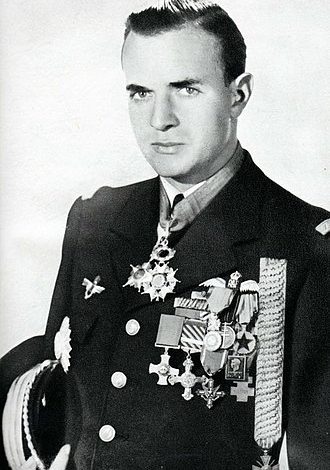Pierre Clostermann

Pierre Henri Clostermann DSO, DFC & Bar (28 February 1921 – 22 March 2006) was a World War II French fighter pilot.
During the conflict he achieved 33 air-to-air combat victories, earning the accolade “France’s First Fighter” from General Charles de Gaulle. His wartime memoir, The Big Show (Le Grand Cirque) became a notable bestseller. After the war, he worked as an engineer and was a Member of France’s Parliament.
Clostermann was born in Curitiba, Brazil, into a French diplomatic family. He was the only son of Madeleine Carlier from Lorraine and Jacques Clostermann from Alsace. After receiving flying tuition from German pilot Karl Benitz (died in 1943, Russia), he completed his secondary education in France and gained his private pilot’s licence in 1937.
On the outbreak of war in 1939 the French authorities refused his application for service, so he travelled to Los Angeles to become a commercial pilot, studying at the California Institute of Technology.[1] Clostermann joined the Free French Air Force in the United Kingdom in March 1942. After training at RAF Cranwell and 61 OTU, Clostermann, a sergeant pilot, was posted in January 1943 to No. 341 Squadron RAF (known to the Free French as Groupe de Chasse n° 3/2 “Alsace”), flying the Supermarine Spitfire.
He scored his first two victories on 27 July 1943, destroying two Focke-Wulf Fw 190s over France.[verification needed] In October 1943, Clostermann received a commission as an officer, and was assigned to the British No. 602 Squadron RAF, remaining with the unit for the next ten months. He flew a variety of operations including fighter sweeps, bomber escorts, high-altitude interdiction over the Royal Navy’s Scapa Flow base, and strafing or dive-bombing attacks on V-1 launch sites on the French coast. He flew air-cover for the Normandy Landings, and was one of the first Free French pilots to land on French soil, at temporary airstrip B-11, near Longues-sur-Mer, Normandy on 18 June 1944. He was awarded the Distinguished Flying Cross shortly afterwards, after which he was reassigned to French Air Force Headquarters.
Clostermann whilst serving with No. 341 Squadron RAF “Alsace”
In December 1944 he returned to the front line on re-secondment to the Royal Air Force as a supernumerary flight lieutenant. He joined No. 274 Squadron RAF flying the new Hawker Tempest Mk V. In an aircraft which he named Le Grand Charles, Clostermann flew an intensive and highly successful round of fighter sweeps, airfield attacks, “rat scramble” interceptions of Messerschmitt 262 jet fighters, and rail interdiction missions over northern Germany over the next two months.
In March 1945 he briefly served with No. 56 Squadron, before transfer to No. 3 Squadron. On 24 March 1945 he was wounded in the leg by German flak, and after belly-landing his badly damaged aircraft was hospitalized for a week. From 8 April 1945 he was commander of “A” Flight, No. 3 Squadron RAF. He was awarded a bar to his DFC.
On 12 May 1945 during a victory fly-past to mark the war’s conclusion, another Tempest collided with his, and as a result an air pile-up occurred with four close formation low-flying aeroplanes of his flight involved, with three pilots being killed. Clostermann bailed out, his parachute opening just a few yards above the ground. He continued operations with No. 122 Wing RAF until he left the military altogether on 27 July 1945 with the RAF rank of wing commander and the French rank of lieutenant.
In his 432 sorties, Clostermann was credited officially with 33 victories (19 solo, 14 shared, most of them against fighters) and five “probables”, with eight more “damaged”. He also claimed 225 motor vehicles destroyed, 72 locomotives, five tanks, and two E-boats (fast torpedo boats). Many references credit him with 29 to 33 victories, although these probably include his “ground” kills of enemy aircraft. Recent, more detailed analysis of his combat reports and squadron accounts indicate that his actual score was 11 destroyed, with possibly another seven, for a total of 15–18 victories.[2][3]
